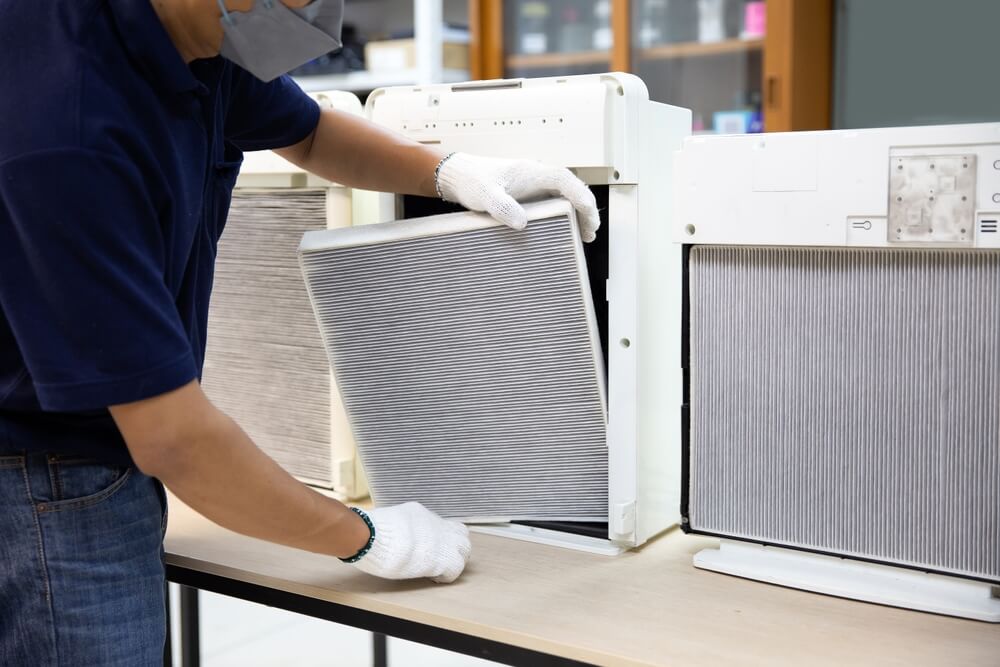Everyone wants their homes to be safe and clean places where they can relax and feel at peace. However, if you don’t frequently sanitize your HVAC system or other components in your home, your indoor air quality may begin to plummet.
Although it may be difficult to notice, bacteria can easily intrude on your home. If you want to ensure your home has a solid defense against these contaminants, consider installing an air purifier for bacteria and viruses.
There are many different styles of air purifiers that target different contaminants and improve your home’s indoor air quality. It’s important to understand what pollutants are present in your home so you can install the right unit.

Signs of Poor Indoor Air Quality
Poor indoor air quality can affect everyone differently, from respiratory issues to skin conditions. If you notice more irritations while you’re at home, you may have some form of contaminant affecting your indoor air quality.
- Persistent Allergy Symptoms: Frequent sneezing, coughing, watery eyes, or congestion, especially when indoors, can indicate poor indoor air quality.
- Lingering Odors: Unpleasant or musty smells that persist even after cleaning or ventilating the space may suggest indoor air pollution.
- Visible Mold or Mildew: The presence of mold or mildew on surfaces, like walls, ceilings, or around windows, indicates high humidity levels and poor air quality.
- Accumulation of Dust: Excessive dust buildup on surfaces, furniture, or HVAC vents can be a sign of poor indoor air quality and inadequate filtration.
- Respiratory Issues: Development or worsening of respiratory problems, such as asthma attacks, shortness of breath, or chest tightness, may be linked to indoor air pollutants.
- Dry or Irritated Skin: Dry, itchy skin or irritation of the eyes, nose, or throat can result from exposure to indoor air pollutants, particularly low humidity levels or airborne particles.
Best Air Purifiers for Viruses & Bacteria
To effectively kill viruses and bacteria in your home, you need to find the best device that meets your needs. The following devices work differently and have different benefits. Before you purchase a unit for your home, it’s wise to consult an air quality specialist who can advise you on the best solution for your home’s needs.
UV Lights

UV lights utilize ultraviolet (UV) light to disinfect the air by targeting and neutralizing bacteria, viruses, and other pathogens. UV air purifiers for viruses and bacteria are typically built with lamps that emit short-wavelength UV light, damaging the microorganisms’ DNA or RNA, and rendering them unable to reproduce or causing their death.
UV-C light purifiers are most effective when installed in HVAC systems or air ducts, where they can treat the airflow throughout the entire home. The cost of a UV-C light air purifier varies depending on the size and functionality of the unit, but generally ranges from $100 to $500.
Photocatalytic Oxidation (PCO) Air Purifiers
PCO air purifiers use a special coating, such as titanium dioxide and UV light, to make reactive oxygen species. These reactive oxygen species react with and break down airborne pollutants, including bacteria, viruses, volatile organic compounds (VOCs), and odors.
PCO air purifiers are typically installed as standalone units in rooms or integrated into HVAC systems. The cost of a PCO air purifier varies depending on the brand, model, and coverage area, ranging from $200 to $1000 or more.
Hydroxyl Radical Generators
Hydroxyl radical generators are among the best air purifiers for killing viruses and bacteria. They produce highly reactive hydroxyl radicals that neutralize and burn away airborne pollutants, including bacteria, viruses, mold, and VOCs. These generators typically use UV light or photocatalytic processes to generate hydroxyl radicals from water vapor in the air.Â
Hydroxyl radical generators are standalone units that can be placed in needed rooms throughout your home. The cost of these devices depends on the size and capacity of the unit, ranging from as low as $400 to as high as $4,000.
Plasmacluster Ion Air Purifier
Plasmacluster ion air purifiers release positive and negative ions into the air, which attach to airborne pollutants such as bacteria, viruses, mold spores, and allergens, neutralizing their surface proteins and making them inactive.
Additionally, these ions can neutralize odors and VOCs by breaking down their molecular structure. The cost of a plasmacluster ion air purifier varies depending on the brand, model, and coverage area, ranging from $100 to $1000.
Consider HVAC Sanitation
While all of the devices above are long-term investments that offer tons of benefits, you could also try HVAC sanitizing in your home’s HVAC system.
During this service, air quality specialists will inspect your air ducts and heating and cooling systems to find any source of contamination and other liabilities. The technicians will then use advanced techniques and cleaners to thoroughly sanitize your HVAC system.
These services are best if you notice strong, musty odors or the presence of mold and mildew in your home. If either of these don’t apply to you, but you’re still suffering from poor indoor air quality, consider installing an air purifier in your home for long-term treatment.
GAC Services is here to help you find the right solution to your problems. Our certified technicians will inspect your home, find the cause of the low air quality, and advise you on the best methods for eradicating the issue.
Contact us online today to schedule an appointment with our experts. We provide our services to Gaithersburg, Frederick County, Montgomery County, and Howard County, Maryland.
Fiber Reinforced Composite Material
Fiber Reinforced Composite Material,Hard Composite Graphite Fiber Felt,Vacuum Furnace Heat Insulation Ring,Insulation Material For Vacuum Furnace
HuNan MTR New Material Technology Co.,Ltd , https://www.hnmtr.com